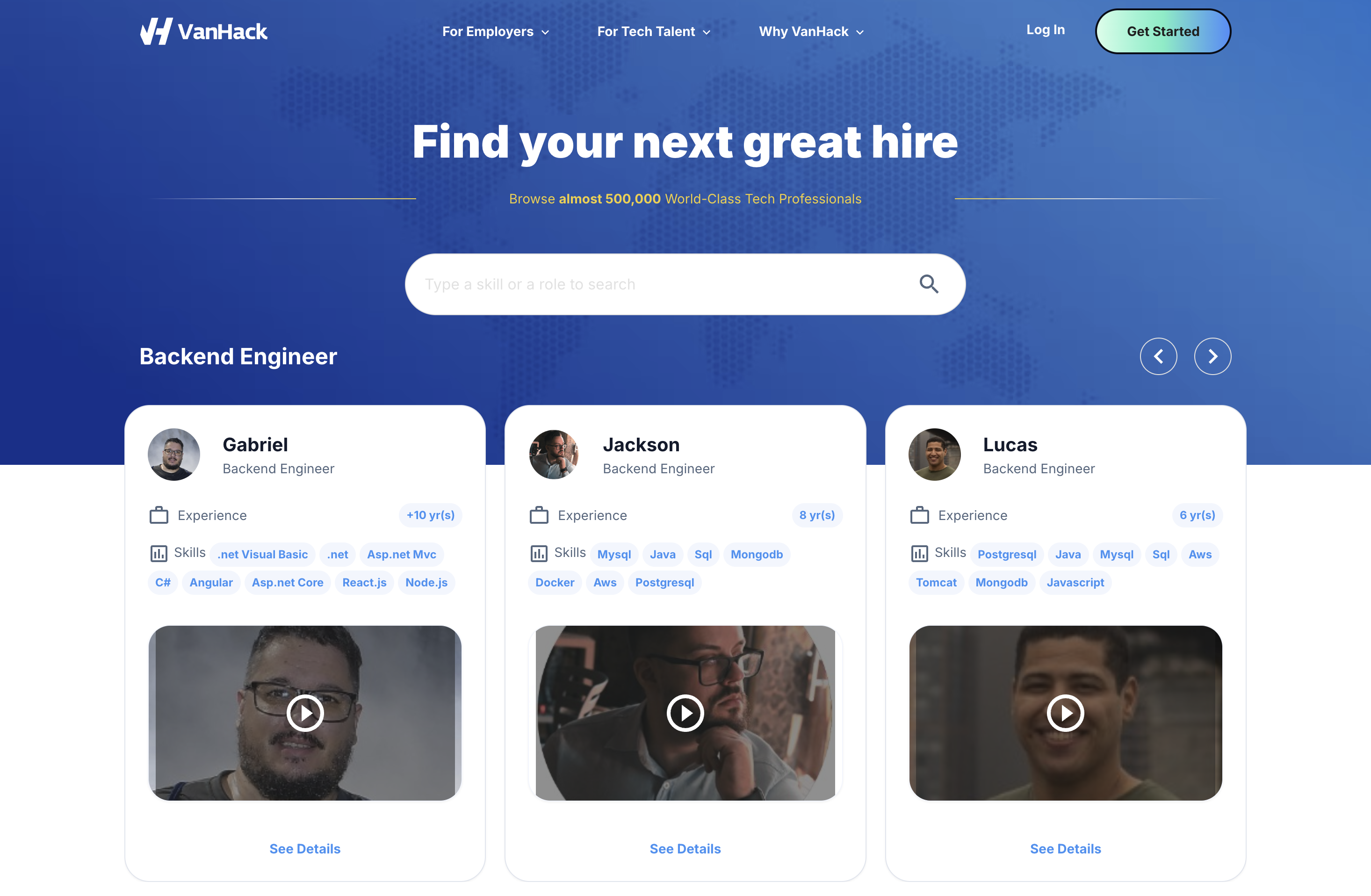Hiring engineering talent has become a core strategy for US startups looking to stay competitive. With remote work now mainstream and the race for skilled developers heating up, old-school recruitment methods like posting on LinkedIn or depending on referrals often fall short. They’re too slow, too costly, or simply don’t deliver the quality needed for fast-growing companies at Series A to C stages.
This guide lays out a clear plan for tapping into remote Latin American (LATAM) developer talent. You’ll find actionable steps on modern hiring practices, defining engineering roles, vetting candidates effectively, and handling global mobility. By the end, you’ll know how to build a strong remote LATAM team that drives growth without breaking the budget. Want to speed up your hiring? Connect with top talent through VanHack.
Key Insights: Hiring Remote LATAM Developers in 2025
The demand for engineering talent has reshaped hiring into a vital skill for US startups. This guide offers a focused approach to recruiting remote LATAM developers, covering the essentials of modern talent strategies, role definitions, and alignment with your business goals.
Here’s a quick look at the numbers. Senior LATAM developers in 2025 often earn 30 to 40% of US salaries, offering major cost savings without sacrificing quality. Additionally, US companies can cut payroll costs by 60 to 70% when hiring skilled LATAM talent, even with rising regional wages.
This guide also highlights advanced vetting tools, global mobility support, and AI-driven candidate matching as key ways to streamline hiring. These methods reduce delays and help you build a high-performing remote team faster, with better retention.
How Engineering Talent Hiring Is Changing
Modern Talent Strategies vs. Old-School Recruiting: What’s Different?
Old recruiting methods, like posting job ads and sifting through applications, worked when talent was plentiful. Today, with fierce competition for developers, you need a proactive approach. Modern talent strategies focus on predicting hiring needs, engaging passive candidates, and keeping a steady pipeline of talent ready.
For startups scaling quickly, this shift matters a lot. Traditional methods often mean long delays in filling roles, overpaying to snag candidates, or ending up with hires that don’t fit. A strategic approach uses data, analytics, and relationship-building to find strong candidates before a role even opens, saving time and improving quality.
This strategy also ties directly to your business plans. Instead of rushing to hire after setting product goals, it aligns hiring with growth phases or funding rounds. That way, you reduce stress and build a team that’s ready to deliver.
Defining Engineering Roles: Senior, Staff, and Principal in LATAM Markets
Engineering titles mean different things across companies, so clarity is crucial when hiring globally. Senior developers usually have 5 to 8 years of experience, solve complex problems independently, and guide junior teammates. They handle tough projects with little oversight and help shape technical decisions.
Staff developers take it further, blending deep technical skills with wider impact. They shape direction across teams, design intricate systems, and boost overall productivity. Often, they’re a bridge between hands-on work and management.
Principal developers sit at the top of the individual contributor ladder. They define technical strategy, influence product direction, and set standards company-wide. Sometimes, they represent your tech expertise to the outside world.
In LATAM markets, these roles may follow different career paths compared to US norms. Remote LATAM developers with international clients can earn two to three times more than local rates, especially in high-demand fields like AI, cybersecurity, or DevOps.
Linking Talent Hiring to Your Business Goals
Your hiring plan should match your product timelines, funding goals, and market strategy. For instance, if you’re gearing up for a Series B round, showing investors you can scale your team fast is key. Timing your hires strategically can boost your valuation and funding outcomes.
Speed in product development often hinges on who’s on your team, not just how many. A few skilled senior developers can speed up launches, improve system stability, and cut technical debt. On the flip side, hiring too fast without proper checks can slow you down with coordination issues.
Your market focus also shapes who you need. Building AI tools calls for different skills than creating enterprise software or mobile apps. Smart hiring anticipates these needs and builds targeted pipelines to match.
Why LATAM Stands Out for Remote Developer Hiring
Global Talent Trends in 2025: Where Does LATAM Fit?
The worldwide talent market has split into distinct areas, each serving different company sizes and stages. Big Tech firms like Google or Amazon pull in elite talent with high pay, but they often prioritize narrow skills over the adaptability startups need.
In US hubs like San Francisco or New York, competition drives salaries to unsustainable levels for early-stage companies. Developers there often field multiple offers, pushing costs beyond reach for Series A or B startups. This has fueled the search for talent elsewhere.
Consulting and outsourcing firms fill a middle ground, offering skilled engineers but often with models that don’t suit startups. Their focus tends to be on short-term projects, not long-term team building or cultural fit.
Remote talent platforms are growing fastest, connecting companies to global talent for cost savings without quality loss. These platforms now offer robust vetting and mobility support, rivaling traditional search firms for effectiveness.
What Makes LATAM a Smart Choice for US Companies?
Latin America offers clear benefits for US startups hiring remote developers. Time zones align closely, so LATAM teams can collaborate in real time during US work hours, unlike regions like Eastern Europe or Asia where delays are common.
Cultural similarities help, too. Many LATAM developers are familiar with US tech frameworks and communication styles from their education or experience. This cuts down on onboarding time and eases team blending compared to other regions.
Talent quality in LATAM has grown sharply over the last decade. Major tech firms have set up bases there, training thousands in current software practices. Universities in Brazil, Mexico, and Colombia now produce graduates with skills on par with top US programs.
Cost advantages remain strong. Median salaries for remote LATAM software engineers in 2025 are around $99,400 USD, roughly 46% below US levels. Even with an 8 to 15% salary rise in the past year, the savings are still significant for US firms.
Salaries vary across the region, giving budget flexibility. Senior developer pay ranges from $52,500 in Costa Rica to $21,300 in Argentina for 2025, while mid-senior remote engineers in Mexico, Brazil, and Colombia average $40,000 USD per year.
Key Strategies for Hiring Remote LATAM Developers
Should You Build a Team In-House or Partner with Experts?
Deciding whether to develop your own recruiting setup or team up with specialized firms is a big call for startups. Building internally gives you control and cultural alignment, but it demands heavy upfront costs and ongoing effort.
An in-house recruiting team often needs a dedicated technical recruiter, costing $120,000 to $180,000 yearly, plus tools and platforms at $50,000 to $100,000 annually. Add in leadership time for planning and reviews, and for companies hiring under 20 engineers a year, these fixed costs can outweigh external options.
Partnering with experts brings instant access to know-how, candidate networks, and tested processes. The catch is choosing the right partner and managing them to ensure fit and quality. Combining external sourcing with internal decision-making often strikes the best balance.
A mixed approach can work well. Keep internal staff to handle process and candidate experience, while outsourcing sourcing and early screening. This saves money while keeping quality in check.
Think about your hiring pace, budget limits, internal skills, and how critical talent is to your success. If you’re in a tight market or pushing for fast growth, external help can often speed things up.
Measuring the Impact and Value of Remote Hiring
Gauging the return on hiring remote LATAM developers goes beyond basic metrics. A key factor is how fast new hires start delivering value to your product and goals, often called time-to-productivity.
Remote hires can hit the ground running compared to those relocating, as they skip the personal upheaval of a move. But this edge relies on solid onboarding and cultural integration plans.
Retention is another vital measure, given the effort of international hiring. Well-supported remote LATAM developers often stay as long or longer than local hires, especially with fair pay and growth paths in place.
Look at product development speed, too. Track sprint completions, feature rollouts, or reduced technical debt. Skilled LATAM developers can often boost pace while easing the load on your current team.
Factor in total hiring costs, including fees, mobility expenses, equipment, and management overhead. Even with all these, US companies still save 60 to 70% on payroll with LATAM talent.
Ready to enhance your team’s output and manage costs better? Discover top developers with VanHack and build a strong remote LATAM team.
Proven Tips for Hiring Remote LATAM Developers with VanHack
How to Vet Remote Developers Beyond Just Resumes
Screening based only on resumes misses the full picture of what makes a remote engineer successful. Effective vetting looks at technical abilities, communication, cultural fit, and readiness for remote work all at once.
Testing technical skills needs clear, measurable methods beyond what candidates claim. Coding tasks, system design challenges, and role-specific tests give solid data on ability. These should mirror real job demands, not just theoretical puzzles.
Communication checks are crucial for remote roles where clarity directly affects teamwork. Video calls, written samples, and joint problem-solving reveal skills better than quick phone chats.
Assessing cultural fit means looking at how well someone matches your company’s values and remote work style. Those who excel with independence and focus on results often thrive remotely, unlike those needing constant guidance.
VanHack’s vetting stands out with layered assessments. Video intros quickly show communication skills and English level, skipping the need for long initial calls.
Coding tests on trusted platforms like Woven offer hard data on skills, scoring not just right answers but also code quality and efficiency.
A standout feature is AI-driven technical interviews. Candidates do 30-minute recorded sessions, giving you insight into their problem-solving and thought process, all with detailed feedback for review.
Easing Global Moves with VanHack’s Mobility Support
Relocating talent internationally is tricky and costly, often needing legal, logistical, and admin skills most startups don’t have. Handling it alone can lead to visa delays, rule breaches, or poor candidate experiences that hurt hires.
Complete mobility support covers visa guidance, logistics, family assistance, and settling in. Complexity depends on the country, family needs, and visa types.
Visa handling alone needs deep knowledge of immigration rules and paperwork. Experts in tech worker visas know the hurdles and timelines that can trip up the process.
Logistics go beyond visas to include housing help, school setups for kids, healthcare access, and basic life support. These services cut stress and improve the move for candidates.
VanHack simplifies this with an in-house team of immigration experts and coordinators managing everything from visas to practical details. This frees up your team while ensuring a professional process.
The real value is in saving time and avoiding the need to build internal know-how for global moves. It also keeps your employer brand strong with a smooth candidate journey.
What Sets VanHack Apart for Remote LATAM Hiring?
Meet VanHack, a platform designed to streamline hiring remote LATAM developers with innovative tools and support.

VanHack’s “All You Can Hire” subscription at $3,000 monthly for unlimited hires through their AI tool “Vanna” cuts costs compared to typical agency fees of $15,000 to $30,000 per hire.
For fast-scaling firms, this is a game-changer. Hiring seven engineers costs just $21,000 with VanHack, versus over $100,000 with traditional agencies. Fixed pricing also simplifies budgeting and removes barriers to hiring quality talent.
Their AI matching, powered by advanced language models, goes beyond keywords to understand job needs and candidate fit, cutting down review time and boosting hire success.
VanHack’s candidate profiles are detailed, offering video intros, AI interview recordings with scores, and coding test results. This depth helps you decide faster without extra screening.
Unlike outsourcing platforms, VanHack’s direct hire model makes candidates true team members with access to culture and growth. You keep full control over team building and retention.
After hiring, local VanHacker groups help relocated staff build social and professional ties in new cities, aiding retention and integration.
How VanHack Compares to Other Hiring Options
|
Feature |
VanHack |
Traditional Agency |
Job Boards |
Outsourcing Platform |
|
Talent Pool Focus |
Pre-vetted LATAM Developers |
General/Specific RPO |
Broad, unvetted |
Global, contractor-focused |
|
Vetting Depth |
High (AI Interviews, Video) |
Variable, often basic |
None |
Moderate |
|
Business Model |
Subscription (Unlimited) |
Per-hire Fee |
Posting Fees |
Ongoing Margin |
|
Global Mobility Support |
In-house, Integrated |
Add-on/Not offered |
None |
None |
This table shows VanHack’s focused approach to LATAM talent, pairing deep vetting with tech and services that competitors often lack or charge extra for.
How to Avoid Common Mistakes in Remote LATAM Hiring
Is Your Company Ready for Global Talent?
Being ready to hire globally means more than just needing staff. It involves checking your setup, processes, and culture for remote team success.
Start with your tech tools. Ensure communication, project tracking, security, and dev environments work smoothly for remote staff. Consistency in access is critical.
Look at your processes. Onboarding, performance reviews, career paths, and feedback need structure for remote workers since casual office interactions aren’t there.
Check if your managers can lead remote teams, handle virtual reviews, and keep everyone connected across distances. This skill often needs training.
Assess cultural openness. Thriving global teams embrace diverse styles and views as a strength, not a hurdle.
Prepare for legal and compliance needs, like employment laws, taxes, IP rights, and data rules in each location. These can affect costs and operations.
Typical Challenges US Teams Face with LATAM Hiring
Many US companies overlook cultural integration, focusing only on skills. Supporting adaptation is key to lasting success. Top LATAM talent prioritizes flexibility, growth, and clear hiring over just pay.
Compliance across borders can trip you up. Differences in labor laws, tax rules, and visas pose risks without expert help, leading to costly mistakes.
Poor onboarding hurts remote integration. New hires need detailed intros, clear roles, and frequent early check-ins, or you risk higher turnover.
Getting pay wrong, either too high or too low, can backfire. Open salary discussions build trust with senior LATAM candidates. Know local rates to stay competitive.
Mismatched tech tools slow remote staff. Ensure they have the same platforms and access as in-office teams for full productivity.
Lack of clear communication rules causes friction. Set expectations for meetings, response times, and teamwork to avoid gaps.
Steer clear of these issues and speed up hiring. Start building your team with VanHack using proven LATAM hiring methods.
Common Questions About Hiring Remote LATAM Developers
Are LATAM Developer Salaries Still Cost-Effective for US Firms in 2025?
Even with recent increases, LATAM developer pay remains attractive for US companies. Salaries rose 8 to 15% last year due to global demand, but senior developers still earn 30 to 40% of US rates, offering big savings.
Median pay for remote LATAM engineers is about $99,400 USD yearly, 46% below US levels. Even after full cost breakdowns, US firms save 60 to 70% on payroll compared to local hires.
Cost-of-living gaps between the US and LATAM keep this edge in place. Developers also value remote flexibility, growth chances, and working with innovative firms, not just pay.
The trick is offering fair, market-based pay with transparency to build trust. Focusing only on cutting costs can hurt retention, while balanced offers lead to strong results.
What Extra Costs Come with Hiring Remote LATAM Talent?
Beyond base pay, US firms face varying costs by country. Benefits and taxes range from 9% of salary in Chile to 40% in Costa Rica, so plan budgets with local details.
Equipment and setup, like laptops, office stipends, internet, and software, often run $3,000 to $5,000 per person yearly, depending on policies and markets.
For relocations, mobility costs like visas, consulting, logistics, and family support can be $5,000 to $15,000 per hire, based on location and family needs.
Remote teams add management costs, including tools, platforms, and HR support for compliance, usually 10 to 15% of direct pay.
Legal and compliance fees for contracts, taxes, and regulations often hit $2,000 to $5,000 yearly per region for expert advice.
Even with these extras, total costs for LATAM hires stay 50 to 60% below US equivalents, keeping savings significant.
How Does VanHack Guarantee Quality in Pre-Vetted LATAM Candidates?
VanHack uses a thorough, multi-step vetting process to evaluate technical skills, communication, and remote readiness, going well past resume checks. Candidates start with video intros sharing experience and goals, showing English skills and clarity upfront.
Technical skills are tested on platforms like Woven, measuring not just solutions but code quality and efficiency, with percentile rankings for comparison.
A unique AI interview tool records 30-minute sessions, capturing problem-solving and communication in real time. You get videos, transcripts, and scores for each answer.
Cultural and remote fit are assessed through work history and collaboration style, targeting candidates who succeed in independent, startup-like settings.
These steps create detailed profiles, letting you pick from pre-qualified talent without extra screening rounds, saving time on senior hires.
Can VanHack Handle Complex Relocation for LATAM Talent?
VanHack offers full mobility services via an in-house team, managing everything from visas to settling in. This removes the burden from your team while ensuring a professional process.
Immigration support covers tech worker visas, paperwork, submissions, and government coordination, with experts aware of country-specific rules and delays.
Logistics include housing, schools for kids, healthcare, transport, and life setup, reducing candidate stress and speeding integration.
Family services support spouses and children with language help, cultural intros, and community links, recognizing senior hires often move with loved ones.
This all-in-one approach saves time and maintains your brand with great candidate experiences, avoiding the need for internal mobility expertise.
After moves, local VanHacker groups connect new hires to social and professional networks, boosting retention and cultural fit in new cities.
What’s the Timeline for Hiring Remote LATAM Developers?
Hiring timelines for remote LATAM developers vary by role difficulty, candidate pool, and your decision speed. For senior roles with platforms like VanHack, expect 4 to 6 weeks from start to offer.
Defining job needs and specs takes about a week. Clear details on skills and culture speed up later steps by matching candidates early.
Sourcing and initial vetting via VanHack’s AI often deliver shortlists in 7 to 10 days, focusing your time on strong options.
Your interviews and evaluations usually take 2 to 3 weeks, based on availability and process clarity. Streamlined steps cut delays.
Offer talks and acceptance wrap up in a week if handled well. Early transparency on pay and role reduces back-and-forth at the end.
For relocations, visas add 4 to 12 weeks by country and type, though hires can often start remotely during processing, contributing early.
Final Thoughts: Gain an Edge with Smart Hiring in 2025
For US startups, building engineering teams now means tapping global talent smartly. Sticking to local, outdated hiring methods brings higher costs, longer delays, and limited access to skilled developers.
Hiring remote LATAM developers offers clear wins: major cost savings, access to talented professionals, time zone alignment, and cultural fit that eases teamwork. Success demands more than just low costs, it needs strong vetting, mobility support, and integration plans.
Data shows US firms save 60 to 70% compared to local hires while getting equal skills and strong remote performance. Advanced screening ensures quality, and mobility services remove global hiring hurdles.
VanHack’s all-in-one solution sets a high standard with AI matching, thorough vetting, flat-rate pricing, and mobility support. This tackles key hiring challenges, offering faster results and better retention.
Startups that adopt these strategies early will lock in top global talent while others lag with old methods. Moving from basic recruiting to strategic talent planning isn’t just an upgrade, it fuels new growth paths and lasting market strength.
Ready to strengthen your engineering team and stay ahead? Find the best talent now with VanHack and shape the future of your team with smart decisions today.



